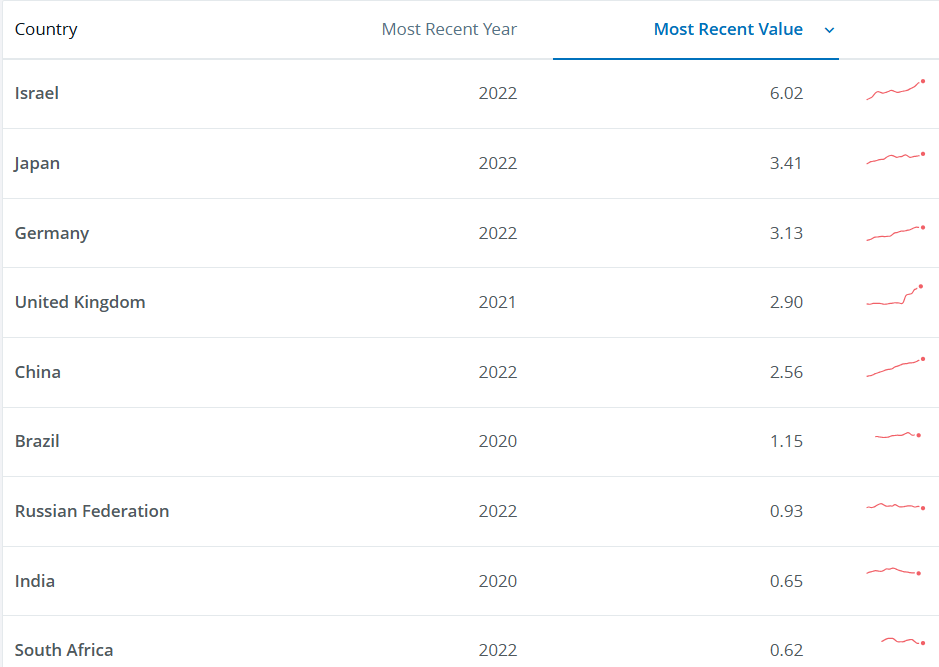The paradox of potential and performance
India, a nation aspiring to be a knowledge-driven economy, faces a stark paradox: its vast human capital and the individual brilliance of its scientists, often demonstrated abroad, do not translate into strong national research and development (R&D) performance. The country’s ambition to grow into a US$5 trillion economy is fundamentally tied to its capacity for innovation, yet its R&D ecosystem is not fit for purpose. This gap suggests the problem is not a deficiency of talent but the absence of a nurturing and enabling environment. India’s path to becoming an R&D superpower is blocked by a combination of chronic underinvestment, deep-seated inefficiencies in its educational and bureaucratic systems, a risk-averse private sector, and cultural norms that often undervalue original research. Overcoming these challenges requires profound, systemic reforms.
Global R&D landscape: India’s position
A comparative analysis shows the significant ground India must cover. As of 2018, the nation’s Gross Expenditure on R&D (GERD) had stagnated at a meagre 0.64% of its GDP for over two decades. By 2021, this had not changed, and the GERD continued to be at less than 0.7 percent. However, the absolute spending rose from 2010 to 2020 from Rs.60,000 Crore to Rs. 1,20,000 Crore. Essentially, money spent on R&D rose while the percent of it, of the GDP has not.
This pales in comparison to R&D powerhouses like South Korea (around 5%), Israel (over 5%), the USA (around 3.5%), and a rapidly advancing China (around 2.5%). The world average is approximately 1.8%. This chronic underinvestment severely limits resources for infrastructure, talent, and high-risk projects.
The following image shows India’s GERD in comparison with other countries, despite the varied years, the general trend is to be noted and interactive data can be found here.

Source: World Bank
Beyond funding, other metrics highlight the challenge. In the 2024 Global Innovation Index (GII), India ranked 39th. While an improvement, it trails key competitors. More telling is the density of research talent: India has only about 255 full-time equivalent (FTE) researchers per million people, a fraction of the figures in the US (over 4,800), Germany (5,400). Furthermore, while patent filings have increased, nearly 75% of patents filed in India are being done by foreign entities, suggesting that domestic ownership and commercialization are weak.
Interestingly, India’s GII rank for ‘Innovation Outputs’ is higher than its rank for ‘Innovation Inputs’. This suggests that the country is relatively efficient at converting its limited resources into outcomes. Therefore, a substantial and targeted investment in improving the inputs—funding, talent, and infrastructure—could yield disproportionately positive results.
Systemic fault lines: The domestic hurdles
India’s R&D underperformance stems from interconnected domestic problems.
- The Educational bottleneck: The foundation of any R&D ecosystem is its education system, but India’s is plagued by challenges. A pervasive culture of rote memorization, driven by an exam-oriented system, stifles the creativity and critical thinking essential for research. Most universities, with few exceptions, lack a strong research culture, adequate infrastructure, and sufficient funding, remaining primarily teaching-centric. A significant disconnect also exists between academia and industry, with India ranking a low 86th in the GII for university-industry R&D collaboration. This gap means academic research rarely translates into market-ready innovations. Compounding these issues is a persistent “brain drain,” where highly skilled scientists and engineers migrate to countries offering superior opportunities, funding, and quality of life. This depletes the domestic talent pool and weakens the entire ecosystem.
- Governance and institutional inertia: The governance framework for R&D is another major obstacle. The system is often crippled by bureaucratic hurdles, including rigid funding rules, long delays in grant disbursal, and complex approval processes that consume researchers’ valuable time. A hierarchical culture, particularly in public R&D organizations, can stifle new ideas from younger talent. Public research institutions often lack the academic, administrative, and financial autonomy needed for agility and innovation, operating under the tight control of regulatory bodies. This contrasts with successful international models like Germany’s Max Planck and Fraunhofer Institutes, which balance autonomy with clear mandates. Finally, even available talent is often used sub-optimally due to skill mismatches and inefficient in hiring and promotions.
- The apathetic private sector: A critical weakness is the low R&D investment from the private sector, which contributes only about 36% of India’s GERD, compared to over 70% in leading economies. This reluctance stems from a general risk aversion among Indian businesses, a focus on short-term profitability, and a preference for importing technology or making incremental innovations rather than engaging in capital-intensive, deep-tech R&D. The fragile innovation ecosystem exacerbates this.
Cultural undercurrents: The societal value of research
Subtle but powerful cultural factors also shape India’s R&D landscape. A strong societal preference for “secure” careers like engineering, medicine, and civil services means research—seen as uncertain and less lucrative—is often deprioritized. The celebrated “Jugaad” mind-set, or frugal, makeshift innovation, while resourceful, can detract from the need for the systematic, rigorous R&D required for breakthrough discoveries. Finally, the portrayal of scientists in mainstream media is often limited and unglamorous, failing to inspire young people to pursue research careers. This cultural undervaluation translates into a lack of political will to enact the long-term, sweeping reforms needed to transform the R&D ecosystem. While this representation aspect is changing slowly, this cannot drive the major change.
Islands of excellence in a sea of mediocrity
Despite the systemic weaknesses, India has pockets of R&D success that demonstrate its potential. The Indian Space Research Organisation (ISRO) is a prime example, thriving due to its mission-oriented approach, operational autonomy, and strong leadership. However, its success is hard to replicate as it largely functions in a closed-loop system as its own developer and end-user. The pharmaceutical sector is another success story, known for its dominance in generic drug manufacturing. Yet, it lags significantly in new drug discovery, with most R&D focused on reverse engineering. Finally, the extraordinary success of the Indian diaspora—including Nobel laureates and tech CEOs who have flourished in the well-funded, ecosystems of the West—is the most powerful testament that the core issue is not a lack of talent but the absence of an enabling environment at home.
Charting a course correction: A multi-pronged reform agenda
To unlock its R&D potential, India must adopt a comprehensive reform agenda.
- Revamp R&D funding: India must increase its GERD to at least 2-2.5% of GDP. This funding should be strategically allocated to national missions in critical areas like AI and renewable energy, while also supporting basic, curiosity-driven research. The government should ensure timely disbursal of funds, and attractive Public-Private Partnership (PPP) models must be developed to boost private investment.
- Transform education: Curricula must be reformed to integrate research methodology, and pedagogy must shift from rote learning to inquiry-based learning. Universities need funding to build research infrastructure and forge stronger, mandatory links with industry.
- Institutional and governance reforms: “Ease of Doing R&D” initiatives must be urgently implemented to cut through bureaucracy. Public research institutions need greater autonomy, coupled with robust accountability frameworks.
- Cultivate a pro-innovation culture: A national effort is needed to improve science communication and make research careers more attractive. This includes encouraging a cultural shift from celebrating only “Jugaad” to valuing deep, original R&D and implementing strategies to attract and retain top talent, including from the diaspora. This also includes a shift in moving beyond the notions of trying to find answers to modern questions in the past.
Conclusion: Realising India’s R&D superpower aspiration
India is at the crossroads. The challenges it faces stem from chronic underinvestment, structural rigidities, private sector hesitancy, and cultural biases. Closing the gap between its potential and performance requires a national mission characterized by unwavering political will and a sustained, multi-decade commitment. A piecemeal approach is doomed to fail. The solution must be a holistic, reform across funding, education, governance, and culture. By transforming its isolated “islands of excellence” into a thriving, interconnected mainland of innovation, India can reach its true potential.
(The author is part of the legal research team of the organisation)
Related:
Alarming decline in quality of research & teaching in Indian Universities
The ONOS scheme for research: What It offers and how it works
